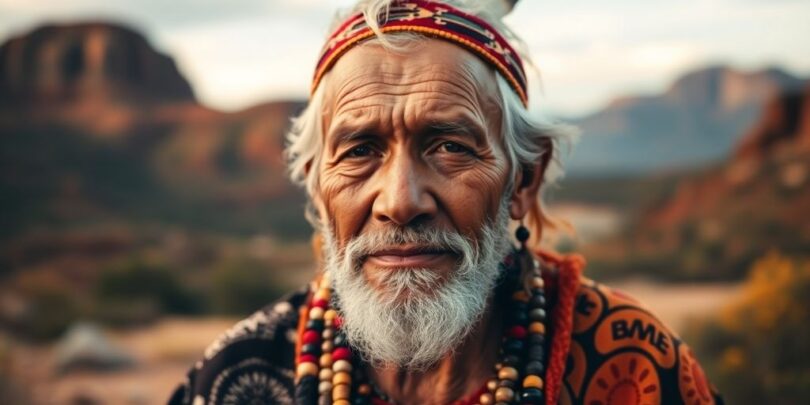Aboriginal life expectancy in Australia has been a topic of significant concern and discussion for many years. Despite various initiatives aimed at improving health outcomes, Aboriginal Australians continue to face challenges that affect their longevity. In this article, we will explore the historical context, current statistics, and the social determinants that influence Aboriginal life expectancy. We’ll also look at the hurdles faced by Aboriginal communities, the government’s response, and community-led solutions that show promise for the future.
Key Takeaways
- Aboriginal Australians have a life expectancy gap of over 10 years compared to non-Indigenous Australians.
- Education plays a vital role in improving health outcomes and can significantly reduce the life expectancy gap.
- Access to healthcare is often limited for Aboriginal communities, particularly in remote areas.
- Government initiatives like the Closing the Gap strategy aim to address health disparities but still face challenges.
- Community-led health initiatives that incorporate cultural practises are crucial for improving health outcomes.
Understanding Aboriginal Life Expectancy
Historical Context of Life Expectancy
Looking back, the story of Aboriginal life expectancy is pretty grim. For a long time, there just wasn’t much data collected, and what was available painted a bleak picture. Early reports highlighted shocking health disparities, but they often seemed to fade away without real change. It’s like the issues were constantly being rediscovered, with little lasting impact. It’s important to acknowledge this history to understand where we are now and why things need to be different. The House Standing Committee on Aboriginal Affairs noted this back in 1979, highlighting the lack of impact of reports on Aboriginal health.
Current Statistics and Trends
Okay, so where are we now? Well, the stats still aren’t great, but there’s been some movement. Generally, death rates among First Nations people have decreased across most age groups in the last decade. However, there was a 4.1% increase in the age-standardised death rate. There’s still a significant gap compared to non-Indigenous Australians, but it’s not a static situation. Things are changing, albeit slowly. We need to keep a close eye on these trends to see what’s working and what’s not.
Comparative Analysis with Non-Indigenous Australians
Let’s be blunt: there’s a life expectancy gap. Indigenous Australians, on average, don’t live as long as non-Indigenous Australians. The reasons are complex and interconnected, but it boils down to a mix of social, economic, and health factors. The gap can be quite significant, sometimes over ten years, and even larger in certain regions like the Northern Territory. Closing this gap is the goal, but it requires a multi-pronged approach that tackles the root causes of the disparity.
It’s not just about healthcare; it’s about addressing the systemic disadvantages that affect Aboriginal communities. Things like access to education, employment, and safe housing all play a role in shaping health outcomes and life expectancy. It’s a big puzzle, and we need all the pieces to solve it.
Here’s a simplified comparison:
| Group | Average Life Expectancy |
|---|---|
| Indigenous Australians | Lower |
| Non-Indigenous Australians | Higher |
Factors contributing to the gap:
- Access to quality healthcare
- Socioeconomic status
- Cultural factors
Social Determinants of Health

Impact of Education on Life Expectancy
Education plays a massive role in health outcomes. It’s not just about getting a job; it’s about understanding health information, making informed choices, and having a sense of control over your life. Better education often leads to better health literacy, which means people are more likely to understand medical advice and manage their health effectively.
Think about it: someone who’s finished school is probably better equipped to navigate the healthcare system, understand preventative measures, and advocate for themselves. This is especially important in Aboriginal communities, where historical disadvantages have created barriers to both education and healthcare. Improving educational attainment can have a ripple effect, improving not only individual health but also the health of future generations.
Role of Employment and Income
Having a stable job and a decent income does more than just pay the bills; it provides security, purpose, and access to resources that support good health. Unemployment and financial stress can lead to poor mental health, unhealthy coping mechanisms, and difficulty accessing nutritious food and healthcare.
For Aboriginal communities, the challenges are often compounded by historical dispossession and discrimination, which have limited access to employment opportunities. Addressing these systemic issues is crucial for improving health outcomes.
Here’s a quick look at how employment can impact health:
- Increased access to healthcare through employer-sponsored insurance.
- Improved mental wellbeing due to reduced stress and increased social interaction.
- Greater ability to afford healthy food and safe housing.
Access to Healthcare Services
Access to healthcare isn’t just about having a doctor nearby; it’s about whether people can actually get the care they need when they need it. This includes things like affordability, transportation, cultural sensitivity, and the availability of services in remote areas.
For many Aboriginal communities, geographical isolation and a lack of culturally appropriate services create significant barriers to healthcare. This can lead to delays in diagnosis and treatment, poorer health outcomes, and a lack of trust in the healthcare system. Addressing these barriers requires a multifaceted approach that includes increasing the number of Aboriginal health professionals, improving transportation options, and ensuring that services are culturally safe and responsive.
It’s a complex issue, but some key areas to focus on include:
- Increasing the number of Aboriginal health workers.
- Improving transport options to clinics and hospitals.
- Ensuring cultural safety in healthcare settings.
Challenges Facing Aboriginal Communities
Geographical Barriers to Healthcare
Living in remote areas makes getting to a doctor or hospital a real struggle for many Aboriginal people. The tyranny of distance is a major factor. It’s not just about the kilometres; it’s about the lack of transport, poor roads, and the time it takes to travel. This can mean delays in getting treatment, which can make health problems worse. Imagine needing urgent care and the nearest clinic is hours away on a bumpy dirt track.
- Limited access to specialists
- Higher costs for medical transport
- Difficulty maintaining regular check-ups
It’s a tough situation, and it highlights the need for more accessible healthcare options in remote communities. Things like telehealth and mobile clinics can help, but there’s still a long way to go.
Cultural Disparities in Health Services
Sometimes, the way healthcare is delivered just doesn’t quite fit with Aboriginal culture and beliefs. This can lead to misunderstandings and a lack of trust. For example, some traditional healing practises might not be recognised or respected by mainstream medicine. It’s important to bridge this gap and make sure that health programmes are culturally sensitive and appropriate.
- Language barriers can make communication difficult.
- Different understandings of health and illness.
- A lack of Aboriginal health workers in some areas.
Socioeconomic Inequities
It’s no secret that Aboriginal communities often face significant socioeconomic challenges. Things like poverty, unemployment, and poor housing can all have a big impact on health. These factors create a cycle of disadvantage that’s hard to break. If you’re struggling to put food on the table or don’t have a safe place to live, it’s tough to prioritise your health.
| Factor | Impact on Health |
|---|---|
| Unemployment | Increased stress, poor nutrition |
| Poor Housing | Exposure to disease, mental health issues |
| Lack of Education | Limited access to information about health literacy |
Government Initiatives and Policies
Closing the Gap Strategy
The Closing the Gap strategy’s goals are pretty ambitious, aiming to reduce inequalities faced by Aboriginal and Torres Strait Islander people. It’s not just about health; it covers things like education, employment, and life expectancy. The government sets targets, reports on progress, and tries to work with Indigenous communities to make things better. It’s had some wins, but there’s still a long way to go. Some targets are proving harder to reach than others, and there’s ongoing debate about whether the approach is really working for everyone.
Health Programmes for Aboriginal Australians
There are a bunch of specific health programmes aimed at Aboriginal Australians. These range from tackling chronic diseases like diabetes and heart disease to improving maternal and child health. A lot of these programmes focus on early intervention and prevention, trying to stop problems before they start. They also try to make healthcare more accessible and culturally appropriate, which is super important. For example, there are Aboriginal Medical Services that are run by and for Indigenous communities. These services play a big role in delivering healthcare in a way that feels safe and respectful.
Educational Reforms and Their Impact
Education is a big piece of the puzzle when it comes to improving health outcomes. The government has put in place a few educational reforms aimed at boosting school attendance and achievement for Aboriginal students. This includes things like:
- Early childhood education programmes
- Targeted support in schools
- Scholarships for higher education
The idea is that if more Aboriginal people get a good education, they’ll have better job prospects, higher incomes, and be more likely to make healthy choices. It’s a long-term investment, but it could make a real difference. The link between education and health is pretty clear, and it’s something that needs ongoing attention.
It seems inconceivable that the education sector, with support, cannot make significant inroads to address the PISA-identified inequities. A starting point on the road to improved educational performance is surely an Indigenous attention to the PISA findings and, while outside the immediate expertise of clinicians, the need to address broad education as a critical component of improving health should require ongoing clinical support for interventions.
Community-Led Solutions

Empowerment through Education
Community-led education initiatives are making a real difference. These programmes focus on culturally relevant teaching methods and incorporating Aboriginal perspectives into the curriculum. It’s not just about academic skills; it’s about building confidence and a sense of identity. When communities take charge of education, they can tailor it to meet the specific needs of their young people. This can lead to better engagement and improved outcomes. For example, some communities are running mentoring programmes where elders share their knowledge and experiences with students. Others are developing resources that reflect local history and culture. These efforts are helping to create a more inclusive and supportive learning environment.
Cultural Health Practises
Traditional healing methods and knowledge play a big role in Aboriginal communities. It’s about more than just physical health; it’s about spiritual and emotional well-being too. Many communities are working to integrate these practises with modern medicine. This means training healthcare workers to understand and respect traditional beliefs. It also means supporting Aboriginal healers and knowledge holders. For example, some clinics now offer traditional healing alongside conventional treatments. This holistic approach can lead to better health outcomes and a stronger sense of cultural pride. It’s about recognising that health is connected to culture and community.
Local Health Initiatives
Local health initiatives are crucial for addressing the specific needs of Aboriginal communities. These initiatives are often run by Aboriginal people, for Aboriginal people. They understand the local context and can build trust with community members. These programmes can range from health education workshops to mobile clinics that visit remote areas. They might also include initiatives to promote healthy eating and physical activity. The key is that they are community-driven and culturally appropriate. For example, a community might run a programme to teach people about diabetes prevention using local foods and traditional knowledge. Or they might organise a walking group that incorporates traditional stories and songs. These initiatives are helping to improve health outcomes and build stronger, healthier communities. The Closing the Gap Strategy is a great example of how government initiatives can support community-led solutions.
Community-led solutions are not just about addressing health issues; they are about empowering Aboriginal people to take control of their own lives and futures. It’s about recognising the strength and resilience of Aboriginal communities and supporting them to build a better future for themselves.
Future Directions for Improvement
Innovative Health Programmes
Okay, so what’s next? We need to think outside the box when it comes to health programmes. Just doing the same old thing and expecting different results? Nah, that’s not gonna cut it. We need programmes that are actually designed with Aboriginal communities, not just for them. Think about using technology more – telehealth, apps for managing chronic conditions, stuff like that. And let’s not forget about preventative care. Catching things early makes a huge difference.
- Telehealth expansion to remote areas.
- Mobile health clinics for on-the-ground support.
- Culturally sensitive mental health programmes.
Research and Data Collection
We need better data. Plain and simple. Without good data, we’re flying blind. We need to know what’s working, what’s not, and where the biggest needs are. And the research needs to be ethical and community-led. No more parachute research where people come in, take the data, and leave without giving anything back. It’s about building trust and working together. We need to address the life expectancy gap and make sure that the data is used to inform policy and practise.
It’s not just about collecting numbers; it’s about understanding the stories behind the numbers. It’s about listening to Aboriginal voices and using that knowledge to create real change.
Collaboration with Aboriginal Leaders
This is the big one. Nothing will work if we don’t have Aboriginal leaders at the centre of it all. They know their communities best, they know what the challenges are, and they know what solutions will actually work. It’s about genuine partnership, not just token consultation. Give them the resources, give them the power, and let them lead the way. We need to improve Indigenous health through education and make sure that the programmes are culturally appropriate.
- Establish Aboriginal advisory boards for all health initiatives.
- Provide funding for Aboriginal-led research and evaluation.
- Support leadership development programmes within Aboriginal communities.
Wrapping Up: The Path Ahead for Aboriginal Life Expectancy
In summary, there’s still a lot to tackle when it comes to the life expectancy of Aboriginal Australians. While we’ve seen some progress, the gaps in education and health outcomes are still pretty stark. Improving education could really make a difference, potentially adding years to life expectancy. It’s clear that we need to keep pushing for better educational opportunities and support for Indigenous communities. This isn’t just about numbers; it’s about real lives and futures. If we can focus on these areas, we might just see a brighter future for Aboriginal Australians.
Frequently Asked Questions
What is the current life expectancy for Aboriginal Australians?
As of recent statistics, Aboriginal Australians have a life expectancy that is significantly lower than non-Indigenous Australians. Males can expect to live about 10.6 years less, while females may live around 9.5 years less.
What factors influence life expectancy in Aboriginal communities?
Life expectancy in Aboriginal communities is influenced by various factors including education, employment opportunities, access to healthcare, and socioeconomic conditions.
How does education impact the health of Aboriginal people?
Better education can lead to improved health outcomes. Studies suggest that higher educational levels are linked to better health and longer life expectancy.
What challenges do Aboriginal people face in accessing healthcare?
Aboriginal people often face geographical barriers, cultural differences in health services, and socioeconomic issues that make it hard to access healthcare.
What government initiatives are in place to improve Aboriginal health?
The government has introduced several initiatives, such as the ‘Closing the Gap’ strategy, which aims to reduce health disparities between Aboriginal and non-Indigenous Australians.
How can local communities help improve health outcomes for Aboriginal Australians?
Community-led solutions, such as promoting education, using cultural health practises, and developing local health initiatives, can empower Aboriginal communities and improve health outcomes.









[…] also focus on things like social and emotional wellbeing, which is crucial. They also advocate for health equity and drive change in the structural determinants of […]